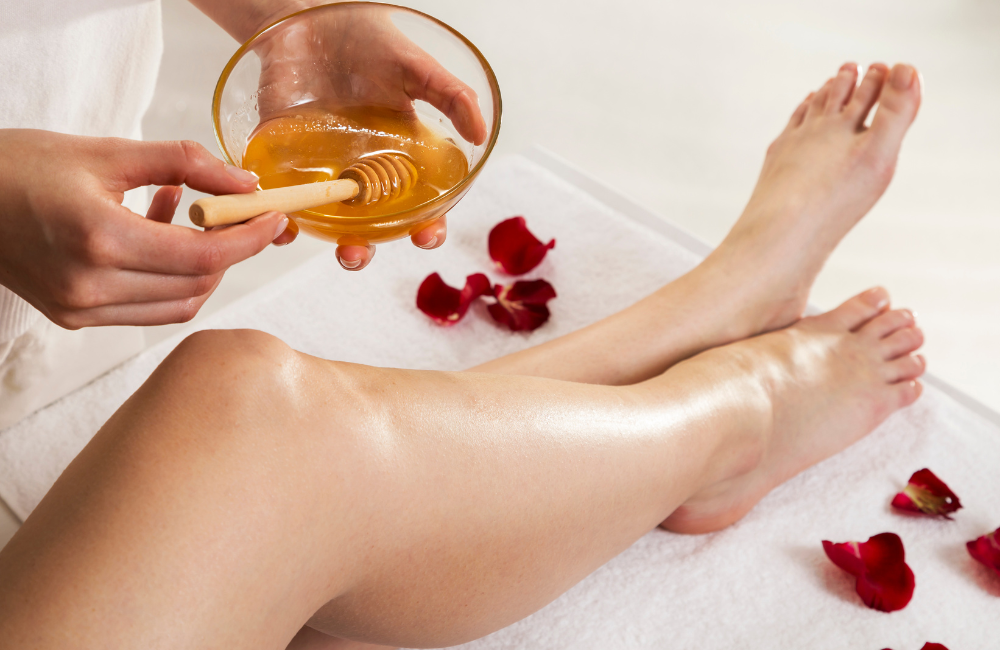
22, Oct, 2024
Smooth Skin and Stress Relief: How Waxing Benefits
Shaving can become a hassle when you have to do it every few days or a week. Therefore, waxing has become a go-to solution for those seeking smooth, long-lasting results without the daily upkeep.
Unlike shaving, which only removes hair from the surface, waxing pulls hair from the root, leaving skin hair-free for weeks, minus razor bumps, and offering smoother skin, zero cuts, and finer hair growth.
Understanding when waxing is beneficial and when to avoid it can help you make informed choices for your skin.
Benefits of Waxing
-
Long-lasting Results
First and foremost, waxing is durable. People who wax regularly can enjoy smooth, hair-free skin for more extended periods than those who shave, saving time and effort on frequent hair removal.
-
Finer and Softer Hair Growth
Regular waxing discourages stubble hair. The continuous pulling of hair from the root weakens the hair follicle after some time, eventually leading to slower and thinner regrowth.
Therefore, the hair that grows back becomes finer and less noticeable.
Over time, the new hair is often softer and lighter in texture, making it less bothersome than the thicker, stubbly regrowth experienced after shaving.
-
Exfoliates the Skin
Waxing provides an added skincare benefit by gently exfoliating the skin.
When the wax is pulled away, it removes not only the hair but also dead skin cells sitting on the skin’s surface. This natural exfoliation leaves the skin smoother and helps prevent clogged pores, making it look more radiant.
By removing the buildup of dead skin cells, waxing also allows for better absorption of moisturizers and other skincare products, enhancing skin health.
-
Reduced Ingrown Hairs
Ingrown hairs occur when hair curls back into the skin instead of growing outward, leading to bumps, irritation, and even infection in the worst case.
Waxing pulls hair from the root, which reduces the chances of sharp, uneven hair tips.
While ingrown hairs can still happen with waxing, they are far less common. Moreover, proper aftercare, like regular exfoliation, can help minimize the risk of ingrown hairs.
-
Less Irritation
Many people experience irritation, such as razor burn or redness, after shaving because the skin is repeatedly exposed to a razor, causing friction.
Whereas, waxing is a less abrasive method since it involves pulling hair in one swift motion rather than repeatedly dragging a blade across the skin.
As a result, most individuals experience less irritation and longer-lasting smoothness after waxing, especially in sensitive areas like the underarms and bikini line.
-
Precision
Waxing is particularly useful when precision is needed, especially for shaping areas like the eyebrows, upper lip, or bikini line. The wax can be applied to specific areas, allowing for detailed shaping.
For example, eyebrow waxing can help achieve a well-defined arch or a cleaner look compared to tweezing or shaving.
The control that waxing offers makes it a preferred method for those who want precise and clean results.
-
No Cuts or Nicks
Shaving often results in minor cuts or nicks, particularly in tricky areas like knees, ankles, or underarms. These minor injuries not only hurt but also increase the risk of infection and scarring.
Meanwhile, waxing eliminates the danger of cuts since no blades are involved. When performed by a professional or done with proper technique at home, waxing leaves your skin smooth and free of the risks that come with shaving.
Is Massage a Good Idea Before/After Waxing?
A massage stimulates blood flow and increases skin sensitivity. Therefore, you must avoid getting a massage right before or after waxing.
The oils and lotions used during a massage can also make it difficult for the wax to adhere to the skin properly.
Likewise, after waxing, your skin is more sensitive, and massaging it too soon can cause irritation, redness, and even breakouts.
A massage might also lead to ingrown hairs or infections, mainly if oils or lotions are used on freshly waxed skin.
However, a gentle massage at least 24 to 48 hours before or after waxing can be helpful, reducing the risk of soreness, pain, or discomfort.
When to Avoid Waxing?
Though waxing offers several benefits, certain situations may make it less healthful.
Here are some instances when it is better to avoid waxing:
- Waxing may cause peeling, swelling, and increased discomfort if your skin is sunburned or highly sensitive.
- Avoid waxing over cuts, wounds, or any infections, including acne breakouts, because it increases the risk of infection or worsens an existing one.
- Likewise, presuming you have varicose veins (underlying enlarged veins close to skin surface), you should avoid waxing, particularly in affected areas, as waxing can aggravate the veins and potentially cause more discomfort or swelling.
- Although it is possible to wax during your menstrual cycle, the skin becomes more sensitive around that time, making waxing more painful and uncomfortable than usual.
- Pregnant women often experience increased sensitivity due to hormonal changes, especially in the skin. Hence, it is best to be cautious and avoid waxing during these times.
- If you have skin conditions such as eczema, psoriasis, or rosacea, waxing may increase irritation, redness, and swelling.
Similarly, individuals taking certain skin-related medications should always consult a dermatologist before waxing.
Final Words
Waxing is an effective way to remove unwanted hair while leaving your skin smooth for weeks. Its benefits range from long-lasting results to reduced ingrown hairs and fewer irritations.
However, waxing is not suitable for everyone, especially in situations where the skin is sensitive, damaged, or under treatment.
Therefore, always pay attention to your skin’s condition and consult a dermatologist if you are unsure whether waxing is right for you.
Furthermore, contact Lemon Massage Therapy for the most facilitated massages, waxing, and spa treatments in Des Moines.
